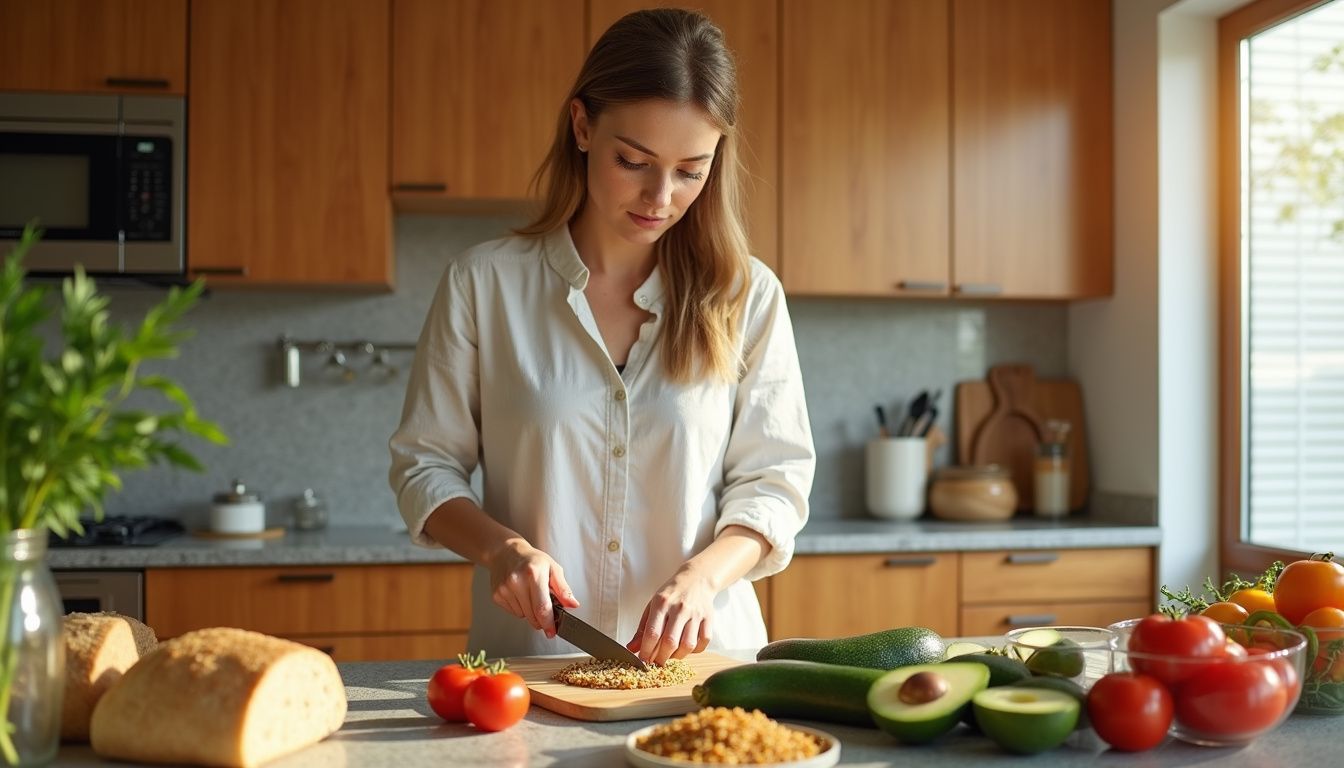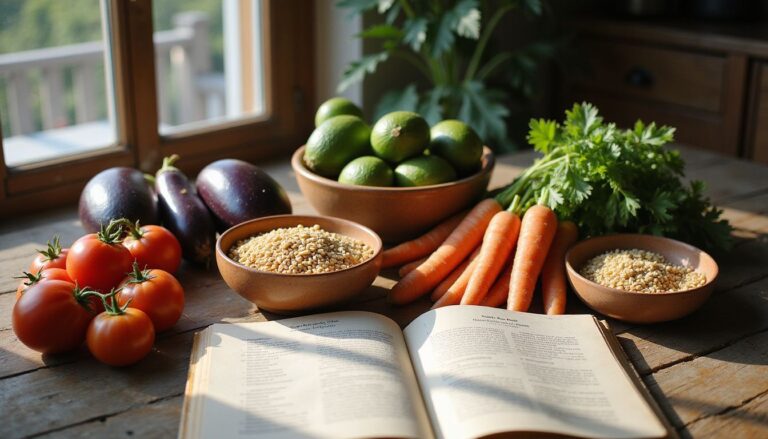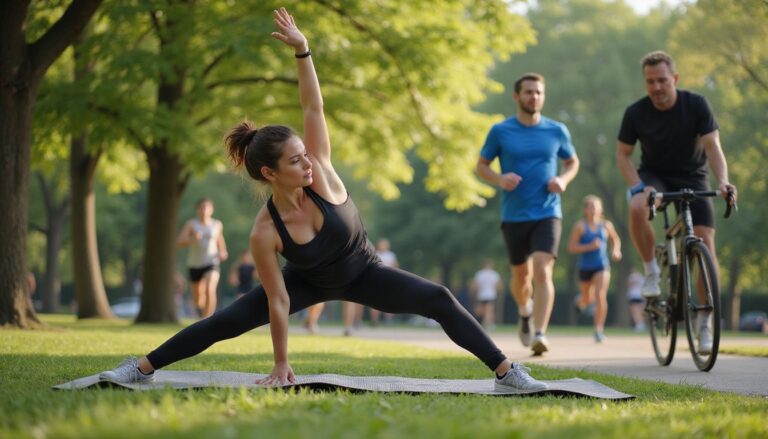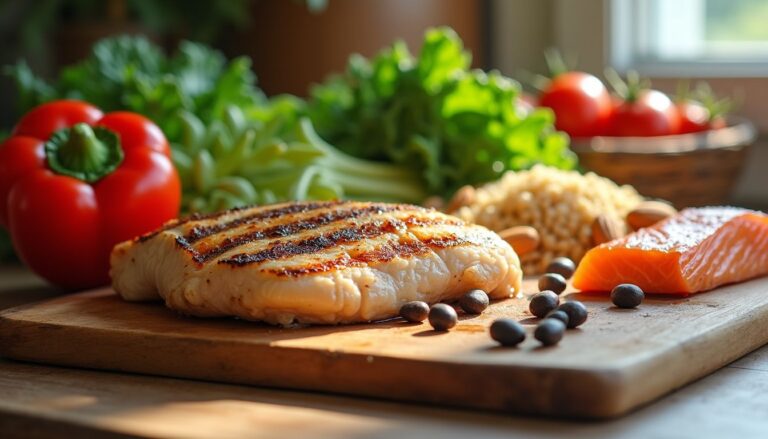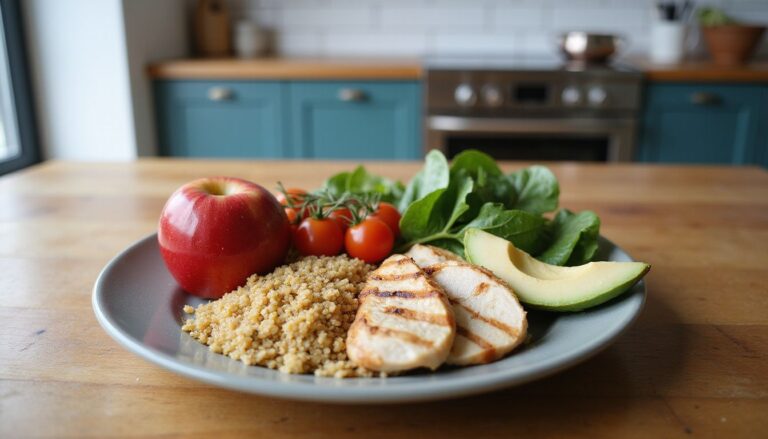Diet Plan To Reduce Weight: Effective Meal Plan For Rapid Weight Loss
Our Nutrition Assistant AI Suite will transform your body. You will lose fat, get toned, and build muscle. Gain confidence and optimal health.
If you have struggled to lose weight or keep it off, you are not alone. A clear diet plan can make weight loss feel easier and more realistic. Research shows that healthy eating habits and smart meal planning support rapid weight loss while protecting long-term health [1].
In this guide, you will find simple steps, proven diet strategies, and a practical meal plan you can start today. Small changes, done often, lead to big results.
[1] Mayo Clinic Staff. “Mayo Clinic Diet: A weight-loss program for life.” Mayo Clinic, 2024.
Key Takeaways
- Balanced 1,200-calorie meal plans with vegetables, lean proteins, and whole grains can support losing 1 to 2 pounds per week, based on Mayo Clinic Diet guidance (2024).
- Low-calorie diets at 1,200 to 1,500 calories per day, and very low-calorie diets near 800 calories, can cause rapid weight loss. Very low-calorie plans require medical supervision.
- Intermittent fasting, such as 16:8 or the 5:2 method, may improve insulin sensitivity and support fat loss when paired with balanced meals and hydration.
- Mediterranean, higher protein, and lower carbohydrate eating styles can reduce heart and diabetes risk while helping with weight management.
- Accurate portions and calorie-free drinks like water or unsweetened tea help you maintain a calorie deficit and reduce cravings.

Key Principles of an Effective Weight Loss Diet

A healthy diet strategy follows evidence and keeps your plan simple. Focus on balanced plates, quality foods, and steady habits that you can maintain.
What are balanced meals for weight loss?
Use the plate method. Fill half your plate with vegetables, one quarter with lean protein, and one quarter with whole grains. Choose lower fat dairy and cook with unsaturated oils such as olive oil.
Structured meal plans can help you stay consistent and feel satisfied. Pair fiber-rich foods with lean protein at each meal to manage hunger and body fat. If you still feel hungry, add a small extra serving of protein, about 1 to 2 ounces or 15 to 20 grams.
Why focus on vegetables, lean proteins, and whole grains?
Vegetables and fruits are low in calories and high in fiber. They add volume to meals, help control appetite, and lower daily calories without leaving you hungry. Non-starchy vegetables like broccoli, spinach, and bell peppers are easy wins.
Whole grains such as brown rice and oats provide more fiber than refined grains. Fiber supports digestion and can help improve cholesterol levels. Lean proteins from fish, poultry, tofu, eggs, and beans help preserve muscle during weight loss and slightly raise calorie burn during digestion.
Eating more veggies helped me feel satisfied even on a 1,200-calorie diet plan.
Choosing nutrient-dense foods like these often reduces cravings for sugary snacks and makes the plan easier to follow.
How can portion sizes be controlled effectively?
Use measuring cups, a food scale, or portion guides to stay accurate. Smaller plates can help you serve less and still feel content. Simple tracking tools make it easier to log meals and activity.
Build meals around the base of the Mayo Clinic Diet Healthy Weight Pyramid, which emphasizes fruits, vegetables, and whole grains. This supports steady progress of about 1 to 2 pounds per week instead of quick fixes from extreme diets.
What are the best calorie-free drinks to stay hydrated?
Water is the best calorie-free drink. Aim for about 6 to 8 cups of fluids daily. Black coffee and unsweetened tea, including green and herbal, are useful options.
Skip sugary drinks like soda and sweetened juices. Replacing them with water or unsweetened tea helps control calories and supports better energy during the day.
Types of Diet Plans for Weight Loss
Different eating plans can help you lose weight. Choose the type that fits your lifestyle, health needs, and food preferences.
What is a Low-Calorie Diet (LCD)?
A low-calorie diet reduces daily intake below your usual needs. Many LCDs range from 1,200 to 1,500 calories per day for women and 1,500 to 1,800 for men. Some plans include meal replacements mixed with regular foods.
Expect steady weight loss of about 1 to 2 pounds per week. This approach allows more variety than very low-calorie plans, which makes it easier to maintain. Adjust calories based on your activity level, and talk with a clinician if you have medical conditions.
How does a Very Low-Calorie Diet (VLCD) work?
A very low-calorie diet limits intake to about 800 calories per day, often using shakes, bars, soups, or medical formulas. It can lead to rapid weight loss and is usually reserved for adults with obesity who need fast results under medical care.
Because the plan is strict, close supervision is required. Side effects can occur, and it is not suitable for children, teens, pregnant individuals, or many older adults unless a clinician approves it. I tried a supervised plan once and learned that careful reintroduction of food is essential to maintain results.
What are the benefits of a Low-Carbohydrate Diet?
Lower carbohydrate eating can reduce body fat and help with type 2 diabetes by improving blood sugar control. Many people also see lower blood pressure and triglycerides, which supports heart health.
Focus on lean proteins, healthy fats like nuts and olive oil, and plenty of non-starchy vegetables instead of refined grains and added sugars. I tested a version of Atkins for three months and noticed fewer cravings and steadier energy.
How does the Ketogenic Diet promote weight loss?
The ketogenic diet aims for ketosis, a state where your body burns fat for fuel when carbs are very low. Many plans limit carbohydrates to about 20 to 50 grams per day, emphasizing healthy fats and moderate protein from foods like eggs, avocados, nuts, and fish.
Some people see quick early weight loss as glycogen and water drop, then continued fat loss with fewer cravings. This plan is not right for everyone, especially if you take certain medicines or have health conditions. Speak with a healthcare professional before starting.
Why choose a High-Protein Diet for slimming down?
Higher protein eating helps control hunger and protects muscle during weight loss. Options include poultry, fish, eggs, Greek yogurt, tofu, and beans.
Reviews of clinical trials show that people may lose more fat and less muscle on diets with higher protein. If you have kidney disease or other medical issues, ask your clinician about safe protein targets.
What makes the Mediterranean Diet effective for weight loss?
The Mediterranean diet highlights vegetables, fruits, whole grains, beans, fish, olive oil, and nuts. You enjoy a wide variety of filling foods, which helps you stay on track without strict rules.
Research links this eating style with lower risk of heart disease, high blood pressure, and stroke. A simple 1,200-calorie day might include overnight oats for breakfast, white bean soup for lunch, and roast chicken with vegetables for dinner.
Meal Timing and Frequency
Timing your meals can steady appetite and energy, much like setting a daily rhythm.
Why is meal timing important for weight loss?
Eating at consistent times supports stable blood sugar, fewer cravings, and better control over portions. Skipping meals can lead to overeating later in the day.
Plan meals around your schedule and physical activity. Regular routines make steady loss of 1 to 2 pounds per week more likely and reduce the chance of weight cycling.
What are the benefits of intermittent fasting?
Intermittent fasting limits when you eat rather than what you eat. The 5:2 method uses two very low-calorie days each week, with regular eating on the other five days.
Studies suggest it can lower body weight and fat mass and may improve insulin sensitivity. Many people pair intermittent fasting with Mediterranean or low-carb meals for better results. I noticed better appetite control after two weeks using a gentle fasting schedule with balanced meals.
How do time-restricted eating strategies work?
Time-restricted eating, such as 16:8, sets a daily eating window. For example, eat from noon to 8 p.m., then fast until the next day at noon. This often cuts late-night snacking and total calories.
Randomized trials show this approach can support weight loss and metabolic health. It does not fit everyone, especially if you have medical or medication needs, so ask your healthcare provider first.
A Simple 7-Day, 1,200-Calorie Diet Meal Plan
This sample plan offers structure, portion control, and balanced nutrition. Adjust portions to your needs if your clinician advises a different calorie target.
What should I eat for breakfast, lunch, and dinner on Day 1?
- Breakfast: 3/4 cup bran flakes, one banana, and one cup fat-free milk.
- Lunch: Mini whole wheat pita with three ounces turkey breast, half a roasted pepper, one teaspoon mayonnaise, mustard, and lettuce. Add a part-skim mozzarella stick and two kiwis.
- Plant-based swap: Veggie Niçoise pitas, about 290 calories per serving.
- Dinner: Four ounces flounder, one cup couscous, and one cup steamed broccoli.
- Dessert: A single-serve ice cream that fits your daily calories.
- Keep flavors simple to reduce decision fatigue during the first week.
- Total intake fits a 1,200-calorie plan that supports significant weight loss for many adults.
What meals are planned for Day 2’s breakfast, lunch, and dinner?
- Breakfast: Smoothie with one cup frozen berries, half a banana, and eight ounces low or fat-free milk. Add one to two hard-boiled eggs for extra protein.
- Lunch: Veggie burger on whole grain toast or an English muffin with one cup vegetable soup and one cup grapes.
- Alternate lunch: Mushroom-quinoa burger for a plant-based protein option.
- Dinner: Barbecue cutlets, about 265 calories each, with citrus slaw or sautéed spinach and half a baked or sweet potato.
- Drinks: Water or unsweetened tea to stay hydrated and limit added sugar.
- This day limits highly processed foods and keeps saturated fat low, which supports heart health in research.
- Meals can be prepared in under 30 minutes and still meet a 1,200-calorie goal.
What does Day 3’s meal plan include?
- Breakfast: Half a cup oats cooked in unsweetened soy milk, topped with half an apple, one teaspoon honey, and cinnamon.
- Lunch: Chicken salad made with four ounces shredded chicken, one fourth cup grapes, one tablespoon chopped almonds, one fourth cup celery, and one tablespoon each mayonnaise and Greek yogurt on lettuce with a slice of multigrain toast.
- Dinner: Four ounces steamed shrimp, a baked potato with three tablespoons salsa and one tablespoon Greek yogurt, plus three cups sautéed spinach.
- Dessert: One ounce dark chocolate or a 100 to 150 calorie ice cream bar.
- Drinks: Water, black coffee, or unsweetened tea. Skip sugary drinks to control calories.
- All items are easy to find in most grocery stores and are budget friendly.
- Meals emphasize protein and fiber to keep you full while you reduce calories.
What are the meals for Day 4?
- Breakfast: One cup plain or low-sugar Greek yogurt, one cup fresh berries, and one third cup low-sugar granola.
- Lunch: One cup tomato soup and a mini whole wheat pita stuffed with three ounces roast beef, a light spread of horseradish, mustard, tomato, and lettuce. Add two cups raw veggies with one fourth cup hummus.
- Dinner: Four ounces poached salmon with a slaw of one and one fourth cups coleslaw mix and scallions tossed with rice vinegar and olive oil, plus one cup cooked quinoa.
- Drinks: Water or unsweetened herbal tea throughout the day.
- Snacks: Raw nuts, apple slices, or carrot sticks if needed within your calorie target.
- Each meal balances protein, fiber, and healthy fats while limiting highly processed foods.
- These choices align with research reviews on reduced-calorie diets.
What should I eat on Day 5?
- Breakfast: One cup Cheerios, half a cup berries, one tablespoon almonds, and six ounces plain Greek yogurt.
- Lunch: Mushroom quesadillas with cucumber spears and either half a cup cottage cheese or a serving of Greek yogurt.
- Fruit: Two clementines for natural sweetness and hydration.
- Dinner: Balsamic-glazed pork tenderloin, about 370 calories per serving.
- Sides: Roasted butternut squash to boost fiber and vegetables.
- Drinks: Water or herbal tea to avoid extra calories from sweetened beverages.
- Keep total intake near 1,200 calories to support a meaningful calorie deficit.
- Include plant-based proteins like beans or nuts for variety during the week.
What is the meal plan for Day 6?
- Breakfast: One whole-grain waffle with two tablespoons nut butter and a sliced banana. Add cinnamon and eight ounces fat-free milk.
- Lunch: Tuna salad made with low-fat mayo and nonfat yogurt. Include ten baby carrots, two thirds cup Greek yogurt, and a small pear.
- Dinner: Spicy sausage jambalaya with three cups sautéed spinach cooked in garlic and one tablespoon olive oil.
- Drinks: Water or unsweetened tea between meals for hydration.
- Snacks: A small handful of nuts if you need extra energy, staying within your calories.
- Choose whole grains to improve fullness and control hunger.
- Use smaller plates to help avoid overeating and manage body fat.
What meals are included on Day 7?
- Breakfast: Sautéed spinach, one tomato, one poached egg, and one ounce reduced-fat cheese on half an English muffin. Add half a grapefruit.
- Lunch: Black bean salad with half a cup black beans, peppers, onions, and scallions tossed in vinegar. Serve with greens, one corn tortilla, and seasonal fruit.
- Dinner: Lentils or chickpeas mixed into brown rice with steamed broccoli or cauliflower.
- Snacks: Fresh fruit or carrot sticks with a small handful of almonds.
- Drinks: Water, herbal tea, or unsweetened coffee throughout the day.
- Keep portions within your 1,200-calorie goal for consistent progress.
- Avoid sugary drinks, processed snacks, and refined grains to cap the week strong.
Foods to Include in Your Diet Plan
Choosing nutrient-dense foods helps control hunger and supports steady weight loss. Start with produce, quality proteins, whole grains, and healthy fats.
Which vegetables and fruits aid weight loss?
Leafy greens, cauliflower, zucchini, tomatoes, and bell peppers are low in calories and high in fiber. They keep you full and add volume to plates. Easy snacks include sliced peppers, cherry tomatoes, and carrot sticks.
Fruits such as strawberries, apples, and bananas add vitamins and natural sweetness. If you have diabetes, watch portions and pair fruit with protein to steady blood sugar.
What whole grains are best for dieting?
Top choices include oats, brown rice, quinoa, and whole wheat pita. Whole grains provide fiber, which supports digestion and helps you feel full.
Keep grains to about one quarter of your plate. Check labels for 100 percent whole grain to avoid refined products marketed as healthy. Swapping white rice for brown rice often helps you stay satisfied longer.
What lean proteins support weight loss?
Lean proteins help protect muscle and curb hunger. Good picks include chicken, turkey, fish, eggs, tofu, beans, cottage cheese, and Greek yogurt.
Use portions that fit your plan, such as three to four ounces at meals. If hunger lingers, add a small extra serving of protein, about 1 to 2 ounces, while staying within your calorie target.
Which healthy fats should I include?
Favor unsaturated fats that support heart health. Use olive oil in salads and cooking. Include nuts, seeds, avocado, and fatty fish like salmon or sardines.
These foods improve fullness and help your body absorb vitamins. Limit saturated and trans fats to protect cholesterol levels.
Foods to Limit or Avoid
Cutting back on certain foods reduces empty calories and helps your eating plan work faster.
Why avoid sugary drinks and snacks?
Soda, sweetened juices, and energy drinks add many calories without filling you up. One can of regular soda has about 150 calories and more than 35 grams of sugar.
Choose water, unsweetened tea, or black coffee. For a sweet bite, pick fruit. You get flavor plus fiber and vitamins.
What are the risks of highly processed foods?
Fast food, fried items, salty snacks, and refined baked goods often contain extra calories, sodium, and unhealthy fats. Regular intake is linked with weight gain and higher risk of diabetes and heart disease.
Reading labels helps you spot added sugars and additives. Many people feel better and less hungry after swapping processed snacks for whole foods.
How do saturated and trans fats affect weight loss?
Foods high in saturated and trans fats can raise cholesterol and slow progress. They are common in fried foods, baked goods, and some processed snacks.
Replace them with healthier fats from nuts, olive oil, and fish. This simple switch supports heart health and weight management.
Why limit refined grains in your diet?
Refined grains like white bread, white rice, and pastries digest quickly and can spike blood sugar. This often leads to more hunger and overeating.
Switch to whole grains for better fullness and more nutrients. Many people find fewer cravings after making this change.
The Role of Exercise in Weight Loss
Think of exercise as the engine that helps your nutrition do more work.
Why is staying active important for losing weight?
Physical activity burns calories and supports a healthy metabolism. Aim for at least 150 minutes of moderate activity each week, such as brisk walking or cycling.
Regular movement also helps prevent regain after you lose weight and improves mood, sleep, and energy.
What physical activities are recommended?
Walk briskly for 30 minutes most days. Add resistance training two to three times per week to build and protect muscle. Cycling, swimming, and dancing are strong options too.
Small tweaks count. Take the stairs, park farther away, and track steps with a phone or watch to stay consistent.
How can combining diet and exercise improve results?
Pairing a calorie-controlled meal plan with regular activity creates a larger calorie deficit. That helps you lose weight faster than diet alone.
Strength training raises your resting metabolism by building muscle, which helps with long-term weight management. Safe progress is about 1 to 2 pounds per week.
Practical Tips for Staying on Track
Simple tools and routines make healthy choices easier on busy days.
How can meal planning help with weight loss?
Planning meals guides your grocery list and reduces impulsive eating. Build each meal around vegetables, lean proteins, and whole grains.
Prepping a few staples, like cooked grains or chopped vegetables, saves time and keeps portions in check. Drinking 6 to 8 cups of water daily also helps tame appetite.
Why use smaller plates for portion control?
Smaller plates make normal servings look generous, which can help you feel satisfied with less. Pair this with measuring cups to stay consistent.
Many people find they can cut calories without feeling deprived by changing plate size at dinner.
How to read food labels for better choices?
Start with the serving size. Check calories, added sugars, sodium, and fiber per serving. Short ingredient lists with familiar foods are usually better.
Pick items that list whole grains, beans, nuts, or vegetables near the top of the ingredient list. Comparing two similar products for sugar and fiber can quickly guide your choice.
How can support from friends or family help?
Support builds accountability and motivation. Share goals with a friend, plan active meetups, or swap simple recipes.
Talking through setbacks makes problems feel smaller and keeps you moving forward. A positive circle makes healthy habits last.
Important Considerations
Safe weight management balances progress with health. Move at a pace your body can sustain.
What is the difference between sustainable and rapid weight loss?
Rapid weight loss is usually more than 2 pounds per week and often needs very low calories. It can raise the risk of gallstones, fatigue, and nutrient gaps.
Sustainable loss targets 1 to 2 pounds per week using healthy meals and regular activity. Habits built at this pace are easier to maintain.
When should I consult a healthcare provider for weight loss advice?
Talk with a healthcare provider before starting any plan if you have medical conditions like diabetes, heart disease, kidney problems, or thyroid issues. Very low-calorie diets, near 800 calories, should only be done with medical supervision and for a limited time.
If you lose weight very fast, or feel unwell, get medical advice right away. A clinician can help you set safe goals and meet your nutrition needs.
Conclusion
Creating a diet plan to reduce weight works best with simple rules and steady habits. Build balanced plates with vegetables, lean protein, and whole grains. Choose water or unsweetened tea, keep portions modest, and schedule regular movement.
A 1,200-calorie meal plan can teach structure and help you practice healthy eating while you lose weight. If you have health concerns, ask a healthcare professional for guidance. Step by step, you can reach a healthy weight and feel stronger week after week.
FAQs
1. What is an effective meal plan for rapid weight loss?
An effective meal plan for rapid weight loss focuses on nutrient-dense foods, portion control, and balanced macronutrients. Research from the National Institutes of Health shows that diets high in vegetables, lean proteins like poultry or fish, and whole grains help reduce calorie intake while maintaining nutrition. For example, a typical day may include oatmeal with berries for breakfast, grilled chicken salad for lunch, and steamed vegetables with baked cod for dinner.
2. How many calories should I eat daily to lose weight quickly?
The recommended calorie intake for rapid weight loss depends on age, gender, activity level, and current body mass. The Centers for Disease Control and Prevention suggests reducing daily intake by 500 to 1,000 calories for safe weekly fat reduction of one to two pounds. For most adults aiming for quick results under medical supervision, this means consuming between 1,200 and 1,800 calories per day.
3. Are there specific foods that support faster fat reduction in a diet plan?
Yes; studies published in the American Journal of Clinical Nutrition highlight that high-fiber vegetables such as broccoli or spinach increase satiety while low-fat dairy products provide protein without excess energy. Whole grains like brown rice or quinoa also support steady glucose levels which can prevent cravings.
4. Can personal experience improve success with a rapid weight loss meal plan?
Personal experience can guide food choices and meal timing based on individual preferences or past outcomes. For instance, after tracking meals for two weeks using a food diary app, I noticed better progress when eating smaller meals more often throughout the day rather than three large ones.
Summary: Rapid weight loss plans work best when they combine evidence-based food choices with calorie control and personal adjustments. Selecting nutrient-rich options such as leafy greens or lean meats supports health while helping achieve goals efficiently.

